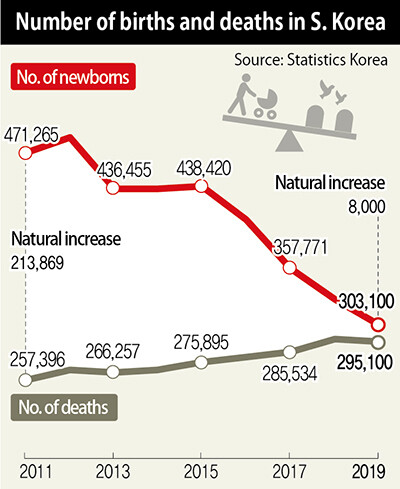hankyoreh
Links to other country sites 다른 나라 사이트 링크
S. Korea expected to see natural population decline in 2020, 9 years earlier than expected

South Korea’s total fertility rate hit yet another record low last year, dropping to 0.92. This rate calculates the number of children a woman is expected to have over the course of her lifetime. The country is expected to see its population begin to decrease naturally this year.
The 2019 figures for births and deaths published by Statistics Korea on Feb. 26 show that South Korea had a total fertility rate of 0.92 last year, the lowest point since the government began to track the figure in the 1970s.
“A total fertility rate below one means that, one generation from now, the number of children born will drop to less than half of the current number,” explained Kim Jin, section chief responsible for population trends at Statistics Korea.
South Korea has the lowest total fertility rate of all members of the Organisation for Economic Cooperation and Development (OECD). Other OECD members with a low total fertility rate are Greece, Italy, and Spain, but all of them have a rate above 1.3.
Last year, a total of 303,100 babies were born in South Korea. That was 7.2% fewer than the 326,822 born in 2018. In the 1970s, the country saw more than a million babies born each year, but that dropped below 500,000 in 2002 and below 400,000 in 2017. Under the current trend, births are likely to fall below 300,000 next year.
The clock is ticking on a natural population decrease. As the number of babies being born sharply decreases, the growth of the elderly population has produced a steady rise in the number of deaths. Comparing births and deaths (295,100) last year resulted in a natural population growth of just 8,000, the smallest figure ever recorded.
“Natural growth of 8,000 is basically zero. If the trend of fewer births and more deaths because of societal aging continues, we’re likely to see natural population decrease occur this year,” said Kim Jin.
Long-term demographic projections for 2017-2067 released by Statistics Korea in March 2019 predicted that the natural decrease of the population would begin in 2019. Since yearly calculations in the long-term demographic projections cover July 1 of one year until June 30 of the next, the prediction that the natural population decline will begin in 2019 (July 1, 2019-June 30, 2020) is likely to come true. In fact, deaths exceeded births in the fourth quarter of 2019, which means that a natural population decrease (-7,300) has already begun on the quarterly level.
According to long-term demographic projections published by Statistics Korea in 2016 (for 2015-2065), the natural population decline was supposed to begin in 2029. But the unexpectedly rapid decline in the birthrate and the progress of societal aging prompted the statistics office to publish an extra set of long-term demographic projections in 2018. In just two years, the expected reversal was accelerated by a decade.
By Noh Hyun-woong, staff reporter
Please direct comments or questions to [english@hani.co.kr]

Editorial・opinion
![[Column] Season 2 of special prosecutor probe may be coming to Korea soon [Column] Season 2 of special prosecutor probe may be coming to Korea soon](https://flexible.img.hani.co.kr/flexible/normal/500/300/imgdb/original/2024/0426/3317141030699447.jpg) [Column] Season 2 of special prosecutor probe may be coming to Korea soon
[Column] Season 2 of special prosecutor probe may be coming to Korea soon![[Column] Park Geun-hye déjà vu in Yoon Suk-yeol [Column] Park Geun-hye déjà vu in Yoon Suk-yeol](https://flexible.img.hani.co.kr/flexible/normal/500/300/imgdb/original/2024/0424/651713945113788.jpg) [Column] Park Geun-hye déjà vu in Yoon Suk-yeol
[Column] Park Geun-hye déjà vu in Yoon Suk-yeol- [Editorial] New weight of N. Korea’s nuclear threats makes dialogue all the more urgent
- [Guest essay] The real reason Korea’s new right wants to dub Rhee a founding father
- [Column] ‘Choson’: Is it time we start referring to N. Korea in its own terms?
- [Editorial] Japan’s rewriting of history with Korea has gone too far
- [Column] The president’s questionable capacity for dialogue
- [Column] Are chaebol firms just pizza pies for families to divvy up as they please?
- [Column] Has Korea, too, crossed the Rubicon on China?
- [Correspondent’s column] In Japan’s alliance with US, echoes of its past alliances with UK
Most viewed articles
- 1[Column] Season 2 of special prosecutor probe may be coming to Korea soon
- 2‘We must say no’: Seoul defense chief on Korean, USFK involvement in hypothetical Taiwan crisis
- 3Is N. Korea threatening to test nukes in response to possible new US-led sanctions body?
- 4Amnesty notes ‘erosion’ of freedom of expression in Korea in annual human rights report
- 5Division commander ordered troops to enter raging flood waters before Marine died, survivor says
- 6N. Korean delegation’s trip to Iran shows how Pyongyang is leveraging ties with Moscow
- 7[Editorial] Korea’s surprise Q1 growth requires objective assessment, not blind fanfare
- 8Is Japan about to snatch control of Line messenger from Korea’s Naver?
- 9No good, very bad game for Korea puts it out of Olympics for first time since 1988
- 10[Reportage] On US campuses, student risk arrest as they call for divestment from Israel